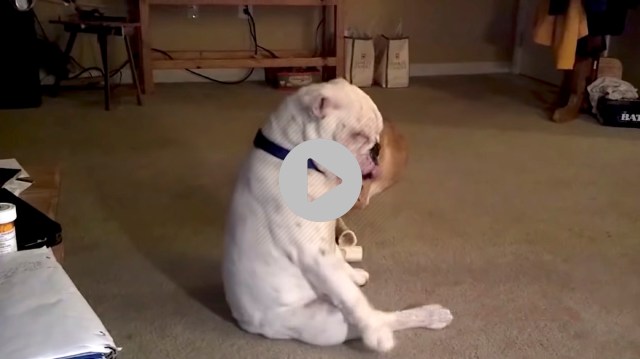Barks Blog
Guess What – That Dog Video Is Probably Fake!
By Eileen Anderson
Many of us are beguiled by videos where dogs appear to be doing something very human or beyond what we usually consider to be their intelligence level, and some creators of dog videos exploit this tendency to get clicks. They make it appear that the dog is doing something he is not, or attribute some pretend, human-centric motivation or interest. And there are people who are willing to alter videos or create mashups so one of these things appears to be happening.
Innocent Misrepresentation of Dogs
Some misleading videos are not deliberate fakery. They are actually published out of misunderstandings of dog body language. Some popular video genres were born of this misunderstanding. One of these is the “cute dog and baby video.” These are videos of infants or toddlers close to or on top of dogs. The humans rave about how wonderfully tolerant the dog is, while the dog is usually getting more and more desperate to escape. (Often the toddlers are roughly handling the dogs.) The caption is often something like, “Oh, Bowser loves the kids! He lets them do anything!” He may love them, but he doesn’t love what the kids are doing. I’ve talked to enough trainers to be concerned about this practice. Both the dog’s and the child’s lives can be at risk. And even if the dog isn’t demonstrating stress, such a video encourages other people into unsafe practices with dogs and babies.
Some good resources for making sure kids and dogs can live together safely are:
I recently published an article about a viral video of a “smiling” puppy, allegedly from happiness from being adopted. Same deal. The new owners likely misunderstood the communication of an appeasement grin. But they did realize that the cute factor could cause the video to go viral.
A related genre is the “guilty dog” video. In most guilty dog videos, the dog is stressed because the human is scolding or threatening them. (In case anybody reading here isn’t aware, there has actually been a study that debunks dogs “acting guilty.” It showed no correlation between a dog performing these behaviors and having committed a misdeed.) The most famous “guilty dog” of them all was a Labrador named Denver. She sometimes performed a classic but rare appeasement signal for dogs: a grin. In her original viral video, her squinting and ducking her head supposedly signified guilt for stealing a bag of food. In later videos, her owner showed her squinting and grinning in other situations, such as when he approached her with ear medicine. Grinning at the prospect of ear medicine undermines the “guilt” theory, but it didn’t matter by then.
Most of the “cute dog and baby” videos, “guilty dog,” and “grinning dog” videos are born of misunderstanding. But then there are videos that appear to be deliberately faked.
Spotting a Faked Dog Video
There are a couple of reasons for the human behavior of fakery, but the primary reason is virality. The makers of these videos generally know the dog was not really doing what they purport. But they want to have a viral video, either to monetize or just for the attention. So they edit and alter a video to fit a narrative.
Here are eight things to look for that can indicate a faked dog video.
- Is the soundtrack removed?
- Is it very short?
- Is there a lot of video editing in a short video?
- Does the video make you go, “Awwww” or “Wow!” and you are amazed to think a dog could do such a thing?
- Are there crucial parts of the scene that you can’t see?
- Is the dog looking repeatedly off camera?
- Is there is mood music added?
- Are there added titles to establish a narrative?
A combination of one or more of these characteristics often means the video was faked. Here are four examples.
The Bulldog “Keeping the Beat” But Not Really
There is a video of a white English bulldog ostensibly “head-banging” to the Nirvana song “Come as You Are.” He rocks and nods his head somewhat in time with the beat. A person is playing a six-string acoustic (i.e. not electric) guitar in the foreground.
This video doesn’t convincingly show a dog feeling and moving to a beat. It is clearly a mashup. Here is the evidence.
- We can’t hear any environmental noise, including the acoustic guitar being played right up front, close to the camera. We hear only the electric bass and drums from the Nirvana song. In other words, it’s not a recording of what’s happening in the room. (You could stop right here. This alone ruins the credibility of the video. )
- The guitarist’s movements on the fingerboard don’t match the music. He’s playing something else.
- The soundtrack is not even the actual Nirvana song. The vocals never come in. We hear only the introduction, looped a few times.
What Really Happened?
Here’s what makes sense to me.
- A guy was playing the guitar while someone videoed him.
- The bulldog walked in, paused a few seconds, then started rocking on his butt, perhaps to scratch his butt or as some kind of stereotypy.
- The person with the camera kept filming and probably had a good laugh.
- Afterward, someone removed the sound from the video and substituted a looped version of the introduction of the Nirvana song. They probably used the looped intro because including the vocals would trigger copyright algorithms in YouTube. YouTube would remove it or sanction them.
- They marketed the movie as an example of a dog moving to a beat.
By the way, the “Nirvana” versions of this video are not the earliest. There is an earlier version posted on YouTube with a blues soundtrack. That version **might** have the original soundtrack, but the dog’s movement is still clearly independent of the music.
To believe that the Nirvana video is as it purports to be, you would have to believe the following string of unlikely events.
- A guy was sitting in his house holding his guitar while a loop of the introduction of a Nirvana song played over his speakers (why the loop?).
- He was simultaneously playing a different piece on his acoustic guitar (why?).
- The two humans, the two dogs, and the acoustic guitar he is playing right in front of the camera are all completely inaudible.
A much simpler explanation is that the Nirvana song was chosen as a good match for the dog’s movement. Anytime the original audio is removed from a video, it’s a good time to get skeptical.
By the way, members of avian species have shown the ability to sense and respond to a beat (Schachner et al, 2009), and a sea lion has been *trained* to do so (Rouse et al. 2016). The Schachner paper linked above also found no evidence of dogs moving to a beat. They examined a lot of video evidence. I haven’t seen any persuasive videos myself since that paper was published. And yes, I’ve seen the golden retriever whose head nods as someone plays the guitar. That video has problems, too.
Holding the Gate for the Golden Puppies: A Trained Behavior

- The adult golden can open the gate and hold it, but almost closes it with half the puppies still inside. She appears stressed.
- She is looking away from the puppies, probably up at a human, a fair amount of time.
- There’s no soundtrack, just cute music.
- The editing is choppy and strange, with two obvious edits in a 19-second video.
The Lab “Rocking” Puppies: No Training, Just Fakery
In this video, we see a lovely yellow lab “rocking” two young puppies in a recliner type rocking chair. She is sitting in front of the chair, with her chin and her right paw up on the chair. The chair is rocking. Look closely. It’s unlikely that the dog is providing the motion. She is responding to it. Her body weight is pushed forward, but the chair is rocking down and toward her. A human is probably pushing the chair from behind. And here is our usual tipoff: we have an added soundtrack of the Brahms Lullaby, music box style. The tinny music was clearly added to the video and not playing in the room.
So the likely scenario is that someone put this lab’s two puppies in the chair, and she came to watch over them. Then someone rocked the chair from behind.
“Dogs rocking babies” is a genre. There are playlists and compilation videos galore. Often, the dog has her paws up on a rocker while a person or a motor provides the rocking. On a few, the dog has been trained to bat or push at the infant rocker and does so on cue. Some retriever types seem to like to rest their chins on a rocker while it rocks. In no case does the dog appear to be rocking the infant to soothe it, as a human would. Yet that is what the creators of these videos would have us believe.
Some establish a narrative using subtitles to make sure you get the message. Here’s one such narrative (I changed the names).
This shiba inu is lending a paw
to rock his baby brother to sleep!
1-year-old Fido loves to push
8-month-old Johnnie in his baby chair.
You can always find him near Johnnie, his mom said.
He is very helpful
and always ready to make sure his little brother is ok.
How sweet!
Props to this one for duration behavior, but you can see the cord from the electric rocker plugged in. Fido is not doing the rocking.
These videos are not cute, to me. I see little point to them. And it’s unwise to show your dog right up close to your infant. People copy things they see others post. The dogs are often right next to an infant’s face, performing a contrived and uncomfortable behavior. Nothing could go wrong there, right?
#eileenruinseverything
Dogs “Hopping To Show Support”

The dog may have a natural limp, or the owner may have trained a front leg limp. But that’s a pretty advanced trick. Somehow that doesn’t fit with the hilarity of the onlookers. And the dog wouldn’t have gear wrapped around its neck.
The smaller dog doesn’t limp; he just does a paw lift near the end of the video, a common sign of stress.
This video does seem to have the original soundtrack. If the dogs are “showing support,” why must the owner beckon them repeatedly?
This video is also looped and slowed down, a common tactic when videos are super short. You will see the major sites do this a lot.
Other Popular Videos That Are Probably Not as They Appear
I’ll add to this section as I see viral dog videos that appear to have an element of fakery.
- The sledding dog. This video shows awesome training. But the versions edited and posted by major media try to make us think that the dog is sledding all on her own as a way of self-entertainment. But the original soundtrack is missing, and the dog is obviously looking at the human for cues. There is a lot of editing and looping, and someone turns the sled around (off camera) at the top of the hill. It’s too bad because the owner did a fabulous job training the complex behaviors of riding a sled down a curved hill, fetching the sled back to the owner, and pulling it up the hill on cue.
- The jumping, turning puppy. This video even made the rounds among dog trainers. Many posted it as an example of “social learning.” In it, a puppy (looks like a pug) jumps—odd, stiff legged little jumps—and simultaneously turns 360 degrees. Then a teenager jumps and twirls, waving their arms. Then the teenager points at the puppy. The puppy jumps, then turns again. We want to believe we are seeing mimicry, but there are several fatal flaws with this claim, including that the puppy does the behavior first. Oops. We are seeing mimicry by a human! The puppy could easily have performed and been rewarded for the behavior a dozen times before the video started. There is no sound, the video is oddly edited, and it’s only 10 seconds long. If I had a puppy who could copy a behavior of mine on cue, I would make a video that truly demonstrated it happening, wouldn’t you? Kudos to the kid for giving the pup a treat, though.
These are my opinions about the videos. I’m open to evidence that I am wrong. Usually, this would be as straightforward as showing the unedited video with the original soundtrack. On some, we would need a different camera angle. This would require that the dog do the behavior again in a similar situation.
I’m always interested in seeing other videos that are not likely showing what they imply or claim to show. Got any?
Thank you to the people who provided me videos when I asked on Facebook for examples. I’m sorry I didn’t write down your names for credit!
References
Rouse, A. A., Cook, P. F., Large, E. W., & Reichmuth, C. (2016). Beat keeping in a sea lion as coupled oscillation: implications for comparative understanding of human rhythm. Frontiers in neuroscience, 10, 257. https://www.frontiersin.org/articles/10.3389/fnins.2016.00257/full
Schachner, A., Brady, T. F., Pepperberg, I. M., & Hauser, M. D. (2009). Spontaneous motor entrainment to music in multiple vocal mimicking species. Current Biology, 19(10), 831-836.
Copyright 2019 Eileen Anderson
About the Author
Passionate amateur dog trainer, writer, and learning theory geek. See more at https://eileenanddogs.com.




